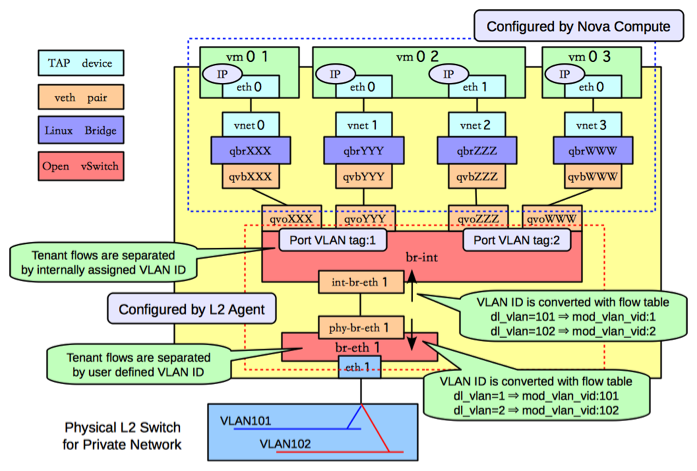OpenVSwitch L2 Agent¶
This Agent uses the OpenVSwitch virtual switch to create L2 connectivity for instances, along with bridges created in conjunction with OpenStack Nova for filtering.
ovs-neutron-agent can be configured to use different networking technologies to create tenant isolation. These technologies are implemented as ML2 type drivers which are used in conjunction with the OpenVSwitch mechanism driver.
VLAN Tags¶

GRE Tunnels¶
GRE Tunneling is documented in depth in the Networking in too much detail by RedHat.
VXLAN Tunnels¶
VXLAN is an overlay technology which encapsulates MAC frames at layer 2 into a UDP header. More information can be found in The VXLAN wiki page.
Geneve Tunnels¶
Geneve uses UDP as its transport protocol and is dynamic in size using extensible option headers. It is important to note that currently it is only supported in newer kernels. (kernel >= 3.18, OVS version >=2.4) More information can be found in the Geneve RFC document.
Bridge Management¶
In order to make the agent capable of handling more than one tunneling technology, to decouple the requirements of segmentation technology from tenant isolation, and to preserve backward compatibility for OVS agents working without tunneling, the agent relies on a tunneling bridge, or br-tun, and the well known integration bridge, or br-int.
All VM VIFs are plugged into the integration bridge. VM VIFs on a given virtual network share a common “local” VLAN (i.e. not propagated externally). The VLAN id of this local VLAN is mapped to the physical networking details realizing that virtual network.
For virtual networks realized as VXLAN/GRE tunnels, a Logical Switch (LS) identifier is used to differentiate tenant traffic on inter-HV tunnels. A mesh of tunnels is created to other Hypervisors in the cloud. These tunnels originate and terminate on the tunneling bridge of each hypervisor, leaving br-int unaffected. Port patching is done to connect local VLANs on the integration bridge to inter-hypervisor tunnels on the tunnel bridge.
For each virtual network realized as a VLAN or flat network, a veth or a pair of patch ports is used to connect the local VLAN on the integration bridge with the physical network bridge, with flow rules adding, modifying, or stripping VLAN tags as necessary, thus preserving backward compatibility with the way the OVS agent used to work prior to the tunneling capability (for more details, please look at https://review.openstack.org/#/c/4367).
Bear in mind, that this design decision may be overhauled in the future to support existing VLAN-tagged traffic (coming from NFV VMs for instance) and/or to deal with potential QinQ support natively available in the Open vSwitch.